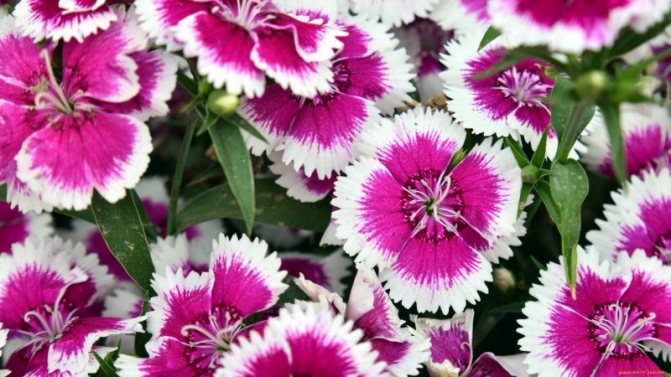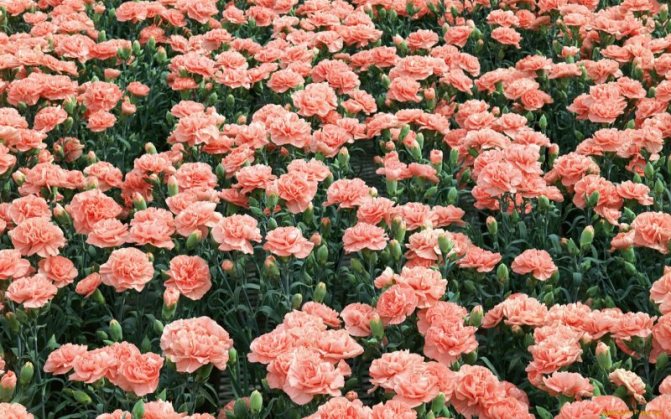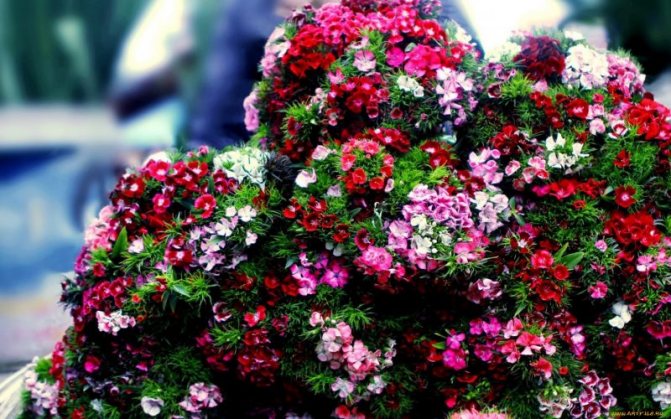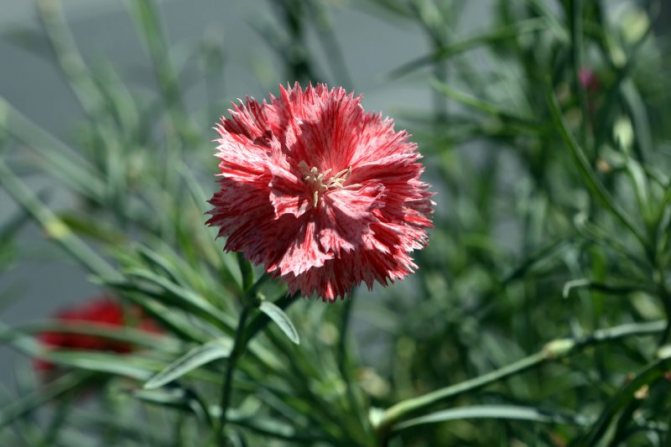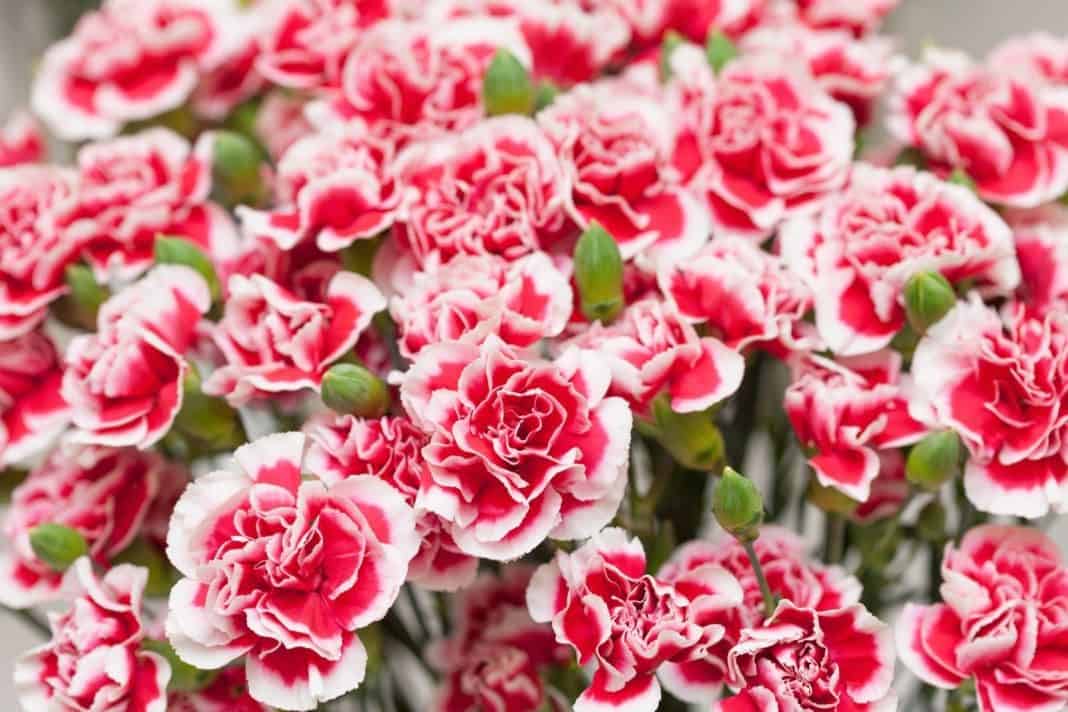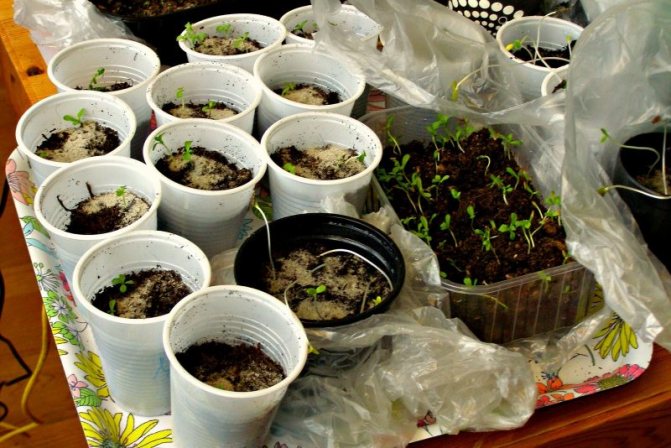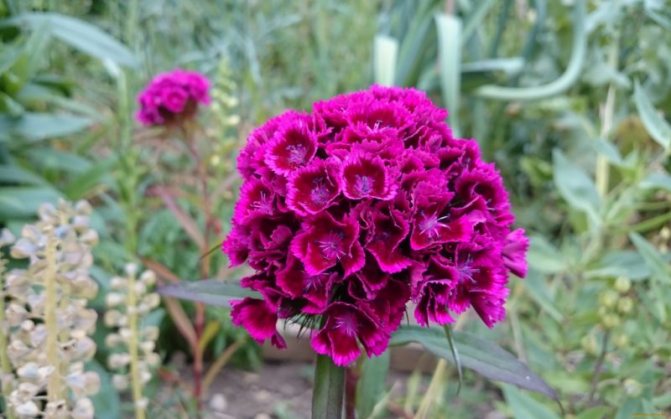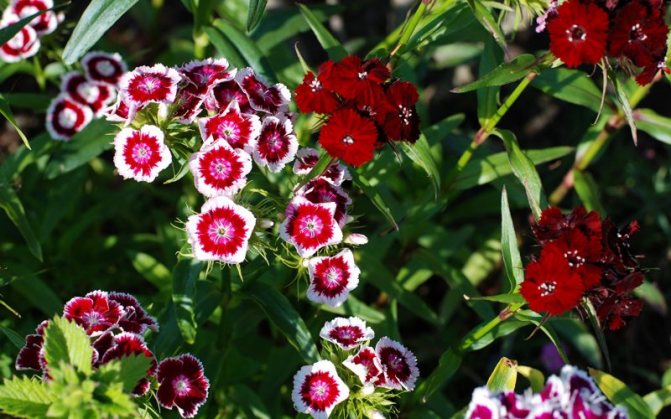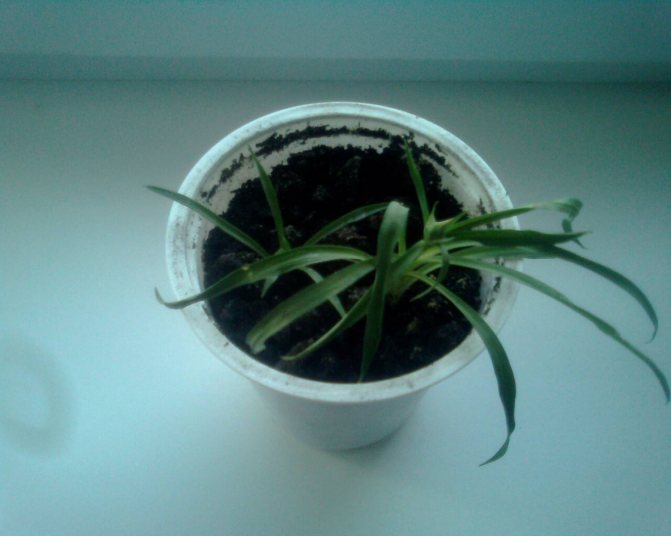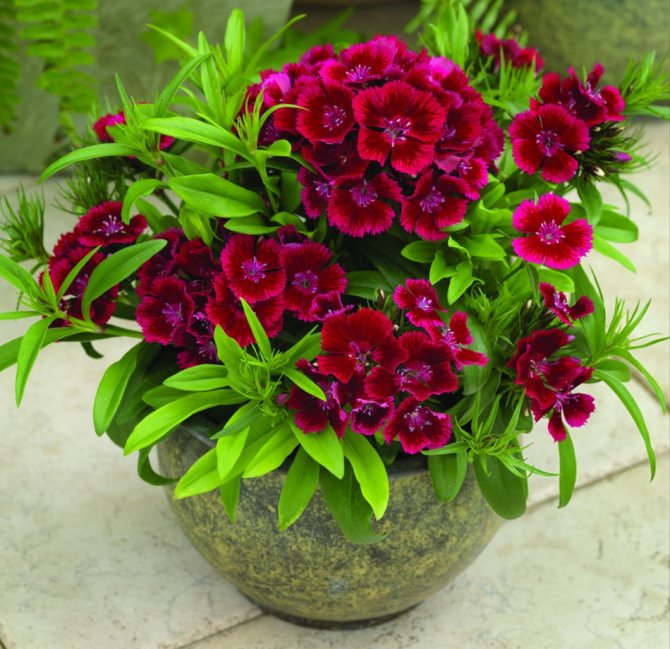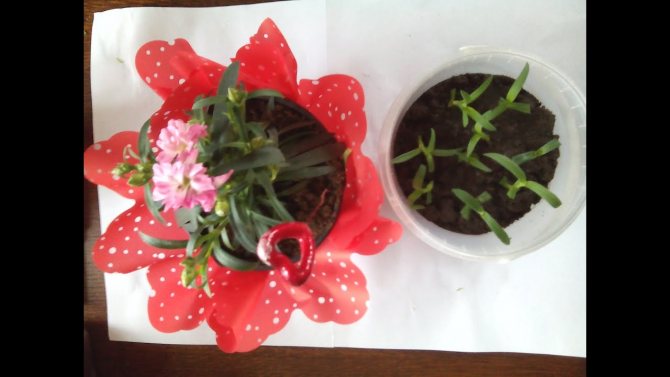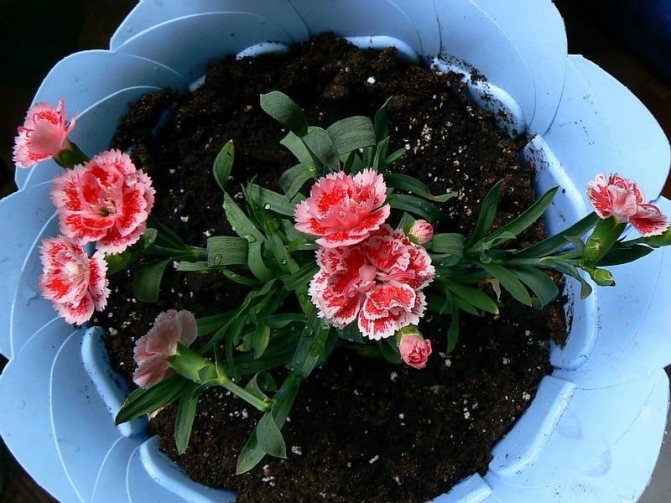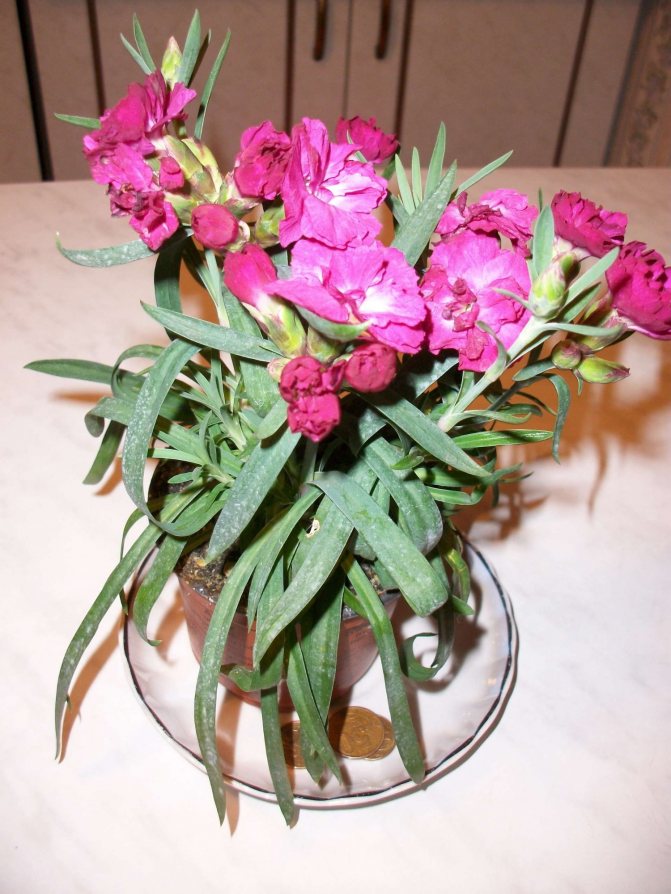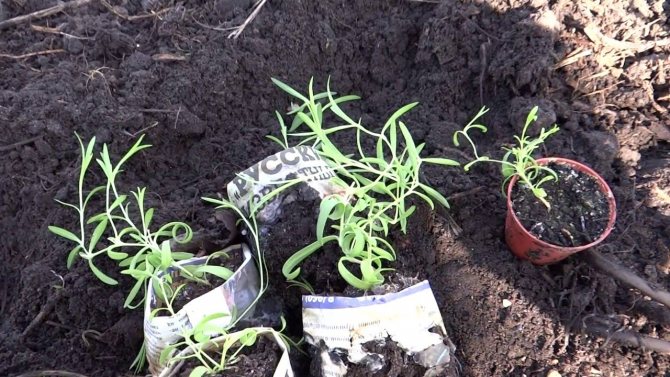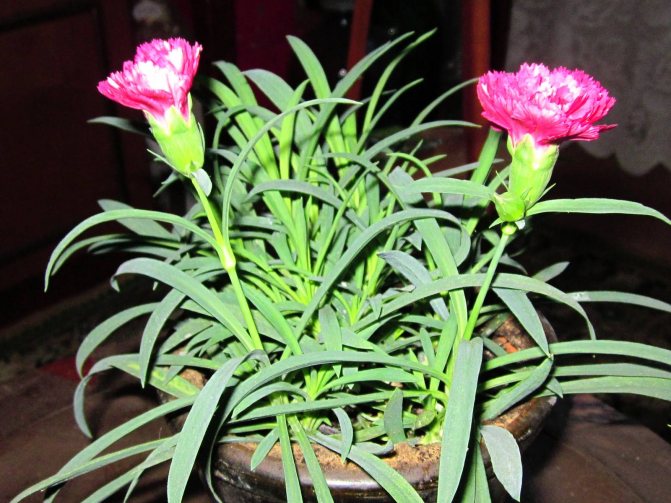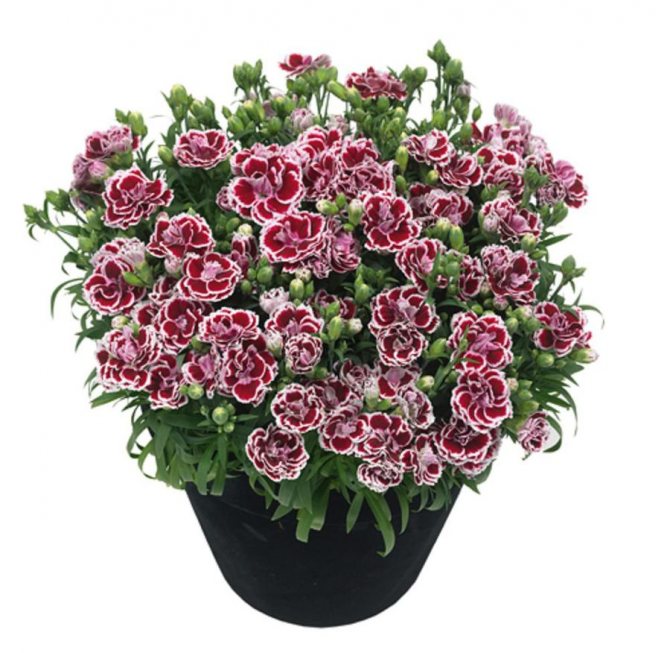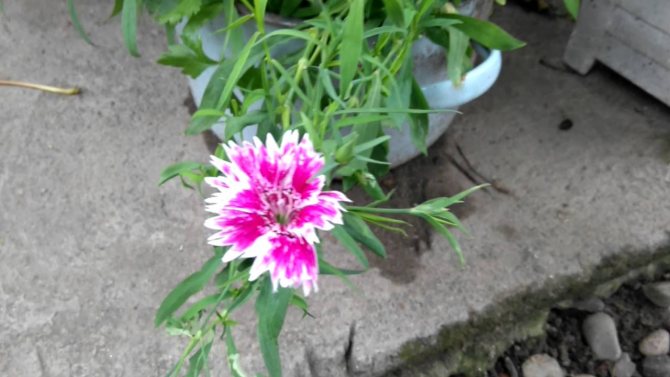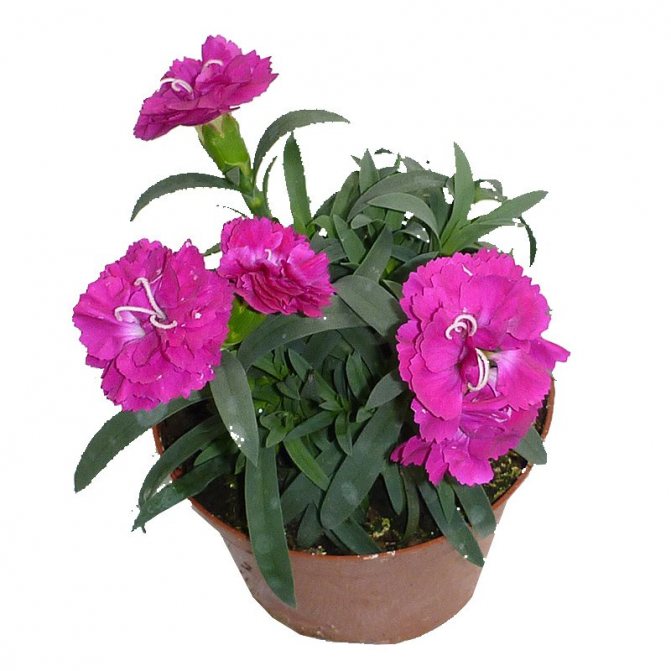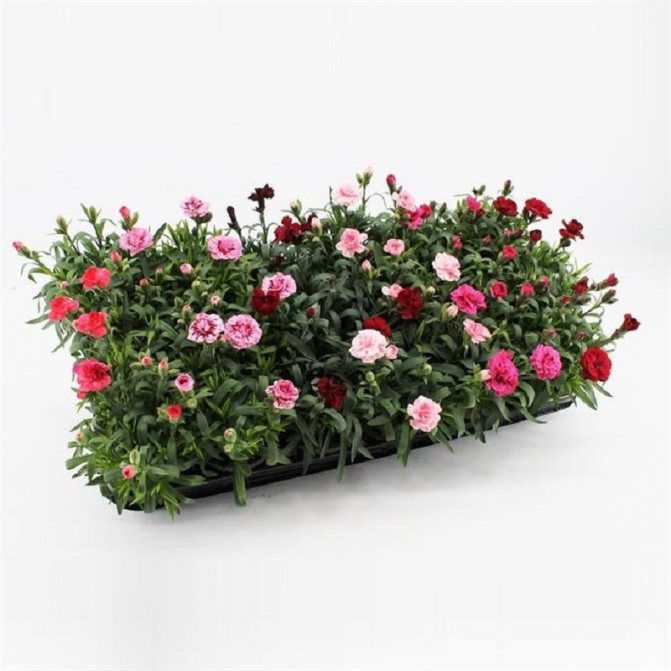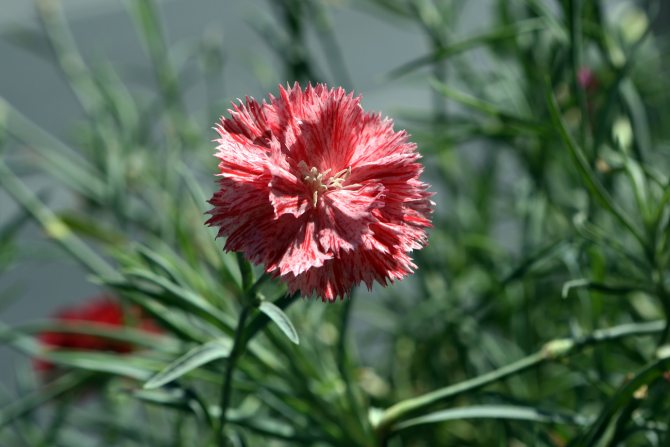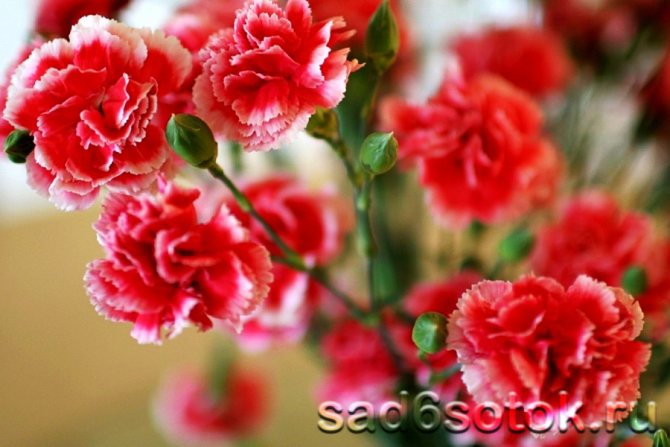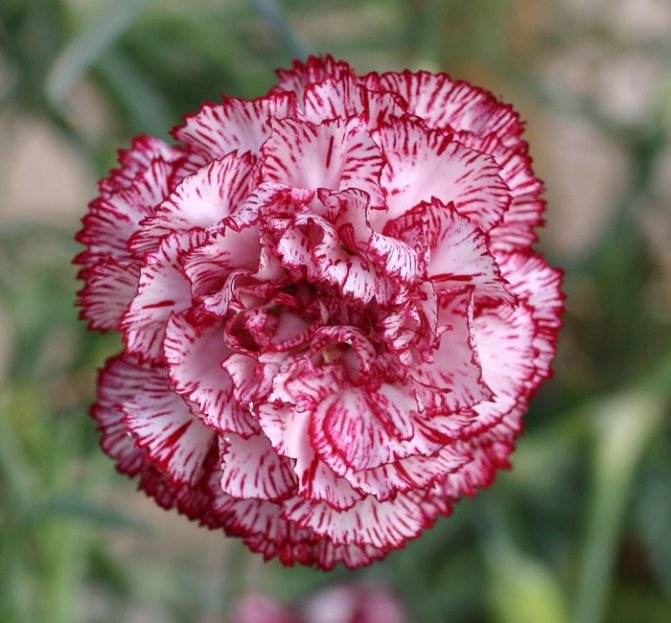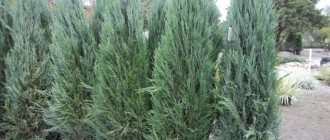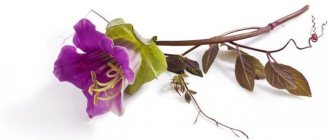The Shabo carnation is the most recognizable and beloved variety of the carnation family by many gardeners. This is a hybrid species, memorable for its aroma and grace. Grown in any region and in almost every area.
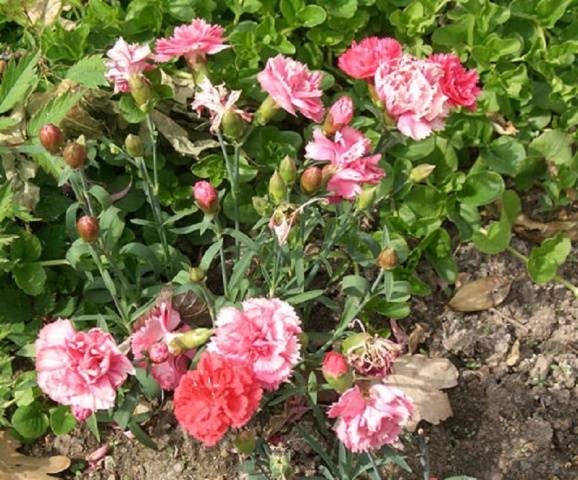
Even fastidiousness in leaving does not stop summer residents. The color scheme of the plant is so diverse that it is difficult to list all the variations. There are monochromatic flowers and mixed flowers, in which shades flow from dark to light. Some people combine several tones in one petal at the same time.
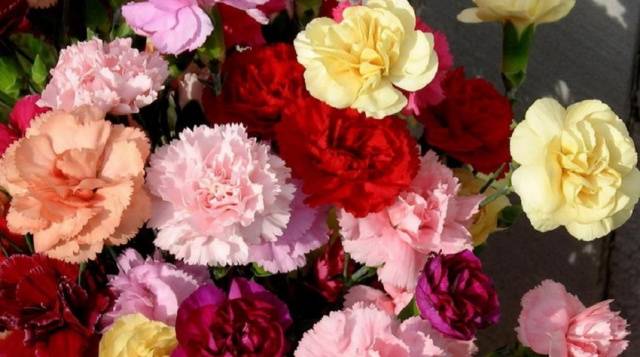

To place a beautiful plant in a flower bed, you need to grow seedlings of garden carnations "Shabo" at home. This is not a simple matter, but the result will make you forget all the troubles. In our article, we will describe in detail the step-by-step process on how to plant a Shabo carnation with seeds.
Description of Shabo carnation
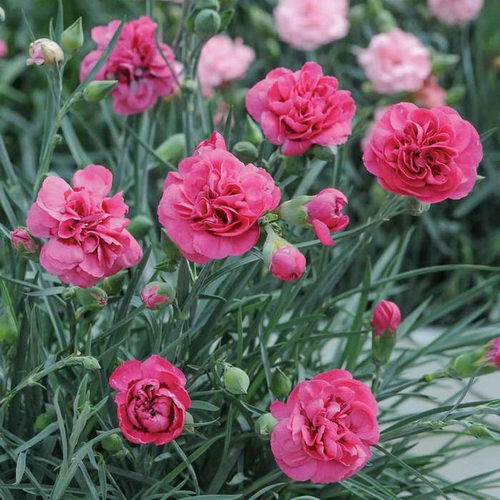

Planting and care of Shabo carnations Shabo carnations photo of flowers on a flower bed in the garden
In Russia, the Shabo carnation is distinguished as a separate independent representative of the carnation family. Western countries consider this hybrid a kind of garden carnation. Both versions have the right to be, the main thing is that beauty is not lost from this. The bush of this type is compact, more often used for bouquet cutting, and landscape designers like to decorate park and city flower beds with them.
- The root of the plant lies at a depth of 10-20 cm, which is enough to obtain nutrients from the lower layers of the soil. The rhizome is long, strong, without lateral processes.
- Thin, linear leaves are gathered at the base of the bush, creating a slight shade that will keep the plant from drying out during the hot sun.
- From the root, there are long, strong, about 60 cm, stems, on which buds with a diameter of 6 cm bloom.
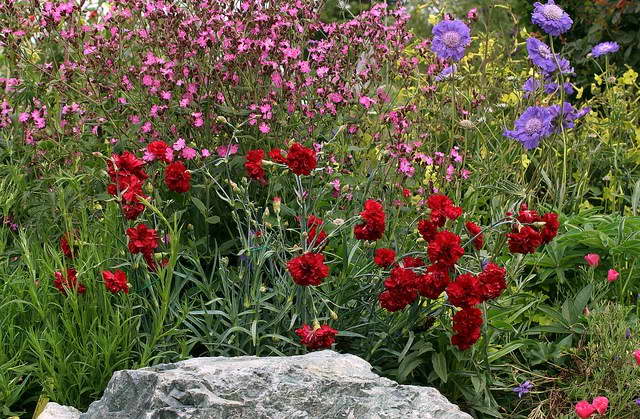

Carnation Shabo in landscape design photo
The Shabo carnation attracts insects and humans with its unique, exquisite aroma, similar to the morning breeze of the South Sea, you can even feel a warm taste. To preserve the aroma, the petals are collected, dried, sachets are created, which are used in decoration and simply as a natural flavoring agent.
The color palette is varied, it ranges from delicate pastels to bright, saturated, dark colors. There are yellow, red, burgundy, purple, pink, beige, white representatives. By combining several color bushes in one flower bed, you can create a three-dimensional composition or a thematic image.
Popular species and varieties
Every gardener resorts to creating their own set of tools in the flower world. To do this, he distinguishes certain varieties from the available varieties of carnations, which are easier to cultivate in summer cottages. Let's take a look at the main ones.
Chinese carnation
The type of Chinese carnations belongs to the category of perennials, although they are often cultivated as an annual. It can be a spreading form of half a meter in height, like a compact grassy one.
Turkish carnation
It is found mainly among biennials, but there are many such annual and perennial varieties. This type of plant is popular due to its own unpretentiousness - it develops independently regardless of the conditions (up to wild plants). Therefore, it is ideal for growing by novice growers.
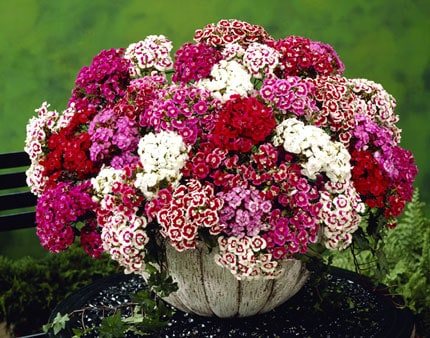

The main difference between the Turkish carnation is its strong trunk, reaching 60cm in height. Numerous small leaves, thyroid heads up to 12 cm in diameter. Small flowers fit quite tightly, not standing out from the environment with their own color, often multi-colored. Among the varieties of Turkish carnations, you can find double and non-double versions.
The most colorful are "Harris Perfekshin" and "Wee Willie". "Summer Beauty" is considered to be of the same type, however, a difference in color is possible. The name of a number of varieties already contains a description of the color - "White".
Carnation Shabo
The most common variant of the annual garden carnation is undoubtedly Shabo.
"Shabo" is the same general name for a large group of beautiful flowers. The plants themselves are very compact, therefore they have an extremely developed root system, which lies approximately 20 cm deep. Thin shoots up to half a meter in height are crowned with double inflorescences up to 6 cm in diameter. Moreover, their flowering can be of different heights.
The numerous list of Shabo carnations is filled with the following options:
- "Zhanna Dionis" is a fairly popular variety at the moment. Its characteristic differences are numerous straight stems of white color.
- "Nero" has strong densely stuck stems. In this case, we can talk about two varieties of saturated red flowers - densely double and medium double.
- "Aurora" is distinguished by dense pink double petals located on the stem.
- erect stems "Rose Queen" of medium degree of terry.
- Etenselana is characterized by a bright aroma. True, the bright red flowers are capable of fading in the sun.
Growing difficulties
Shabo begins to bloom six months after planting, which is not always convenient. December frosts, lack of sunlight may not give good germination and growth results. Seedlings are prepared in advance so that by the end of May full-fledged bushes are formed, ready for transplantation. Flowering continues throughout the summer until the first frost, which depends on the climatic characteristics of the region and local changes in the weather.
Is the Shabo carnation annual or perennial?
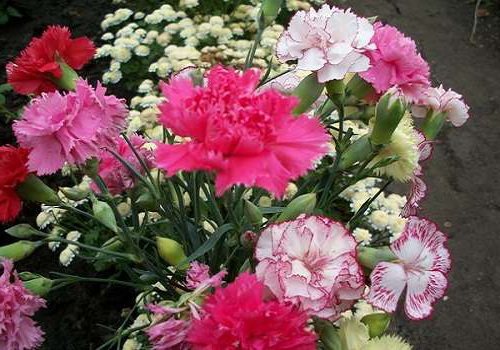

Shabo carnation in the garden
In general, the plant is a perennial, but in frosty winters it dies without additional protection, therefore it is often grown as an annual.
Despite the difficulties of growing, the plant has received its recognition among flower growers for its beautiful appearance and aroma. Following agricultural techniques, a carnation can be grown by anyone, both a beginner and an advanced specialist in floristry.
When to transplant Shabo cloves?
The plant does not tolerate the cold, therefore, when the daytime temperature drops to 10 degrees Celsius, the bushes are dug up and brought into the room where growth continues. So in any region you can save a flower until next year..
To make flowers last longer
To prolong the life of the bouquet, change the water regularly, rinse the walls of the vase and rinse the stems of the flowers. After removing the bouquet from the vase, trim the stems by an inch, holding them under running water, and only then put them back in fresh water. To keep the greens of the flowers fresh, spray them from time to time with a spray bottle.
To help new buds open faster, periodically remove old dried flowers. The flowering process can be greatly accelerated by adding a little vodka to the vase.
If several flowers in a bouquet began to fade earlier than others, select fresh ones, rinse, cut and place in another container. Plants with signs of wilting are immersed in water until the flower itself.
There is also an emergency method for helping flowers:
dip the stems in boiling water for a few seconds. Hot water will expand capillaries and activate vital processes.
- Do you like cut flowers? Vote
Carnations (Dianthus) are wonderful plants for garden decoration. The advantage of a variety of carnations is the abundant and long flowering, very bright and attractive. In addition, the spectacular flowers of many carnations emit a pleasant scent.
I really love carnations, I buy seeds of different types and varieties. And yet not a single carnation disappointed me, and some literally stunned me with their charm!
Reproduction of Shabo carnation by seeds
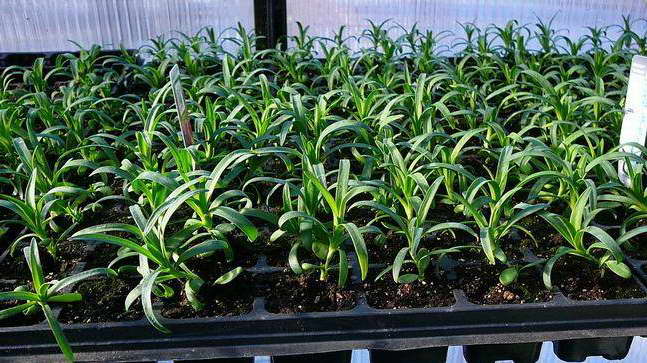

Carnation shabo growing from seeds photo seedlings
The seed method of growing Shabo carnations is considered the easiest, therefore, after the seeds ripen, they must be collected.
Seed collection
It is not easy to obtain seed on your own, this is due to late flowering and short-term warm autumn weather. For full maturation, the plant needs dry, sunny weather with positive night temperatures. This condition is difficult to comply with in central Russia, but in the south of the country it is possible. Therefore, more often seeds are bought in a store, where you can choose a suitable representative among a wide variety. For self-collection of seeds in regions with early autumn frosts, the bushes are transplanted into tubs with soil and brought into a warm room.
There are about 500 seeds per 1 g, they are so small. The germination rate is high, up to 90%, but the sprouts themselves are very thin, even water can injure them. It is better to check the collection time before buying, as not all manufacturers indicate on the package. The flower remains viable for three years from the moment the seeds ripen, otherwise the attempt to grow seedlings will be crowned with failure.
The seeds need about 40-60 days to ripen, so the inflorescences are cut off, tied with a transparent cloth, polyester or tulle, and wait until the flower is completely dry. Ripe seeds spill out easily, so a prepared canvas bag will come in handy.
Seedling soil
Light soils with a neutral alkaline reaction, sold under the stamp "universal", are ideal for Shabo cloves. Such substrates contain the required amount of mineral and organic fertilizers, and the ratio of peat, sand, earth is ideal for flower crops. If you prepare the seedling soil yourself, then you will need land from the proposed flower bed, peat, river sand, which should be half as much. Before planting, the soil is spilled with a universal solution of mineral fertilizers to ensure full growth of the plant.
Preparing containers for seedlings
The seeds are not large, so the sprouts do not need a lot of space at the initial stage. Small cups up to 6 cm with drainage holes for root watering and airing the roots are suitable. Perforation of the bottom will help to avoid stagnation of water, which is dangerous for seedlings by the appearance of rot, wilting of leaves. All containers are subject to mandatory disinfection so that the roots do not get a fungal infection during germination. A weak solution of manganese is suitable, which is poured over or soaked for 10-15 minutes.
Growing Shabo cloves from seeds When to plant
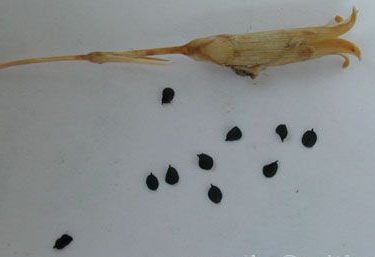

Shabo carnation seeds photo
Sowing time should be carried out six months before disembarking at permanent placeso when the average daily temperature rises above 10 degrees. The southern regions are planted in early May, in regions with a sharply continental climate, the dates are shifted by a month. If the sowing time falls on December-January, then you need to take care of additional lighting. Natural light in the room will not be enough, special fluorescent lamps, botanical light sources that simulate the sun's rays will do.
The seeds do not sink into the ground, but are scattered over the surface, and calcined sand is sprinkled on top. So it will not be difficult for filamentous seedlings to break through the topsoil.
Advice.To ignite the sand, it is enough to place it in an even thin layer in the oven or oven for 20-40 minutes at a temperature of 60-100 Cº. Calcined sand will help avoid blackleg damage during the germination stage. Pre-soaking in a growth promoter is not required: seedlings appear quickly without an additional activator. The seeds are difficult to move into the soil after soaking, they stick together and are unevenly distributed over the surface of the nursery.
- It is better not to make grooves, but to randomly distribute over the surface at a distance of 1 cm from each other. So each sprout will have enough space for development, and the inter-row space will not be empty.
- When picking, the sprouts are easily separated from each other, their root system does not intertwine with each other.
- From above, the nursery is tightly covered with a film until the first shoots appear, then the film is removed.
- When condensation appears, it is shaken off, the greenhouse is ventilated daily to ensure a sufficient amount of oxygen.
Growing conditions for seedlings of Shabo carnations
A little light is required, but the length of daylight hours should be at least 8 hours. The temperature for germination should not be higher than 20 Сº. If the thermometer rises higher in the room, then it is necessary to ventilate more often. Even 15 Сº is not terrible for seedlings, the carnation does not feel discomfort. High temperatures slow down seed germination, so any jump in the thermometer will adversely affect the sprouts.
- The moisture content of the soil should be high, but without stagnant water, which causes rot in the plant.
- Daily morning spraying from a spray bottle will help prevent the topsoil from drying out, the seedlings will receive the required amount of water. Watering can only be done from a spray bottle with a fine spray, without bringing the stream of water close to the ground, otherwise the top layer of the soil will be washed out.
- Water can be used settled, thawed or rainwater, collected outside the city in a clean area.
The first shoots can be observed in 4-5 days, they can be easily noticed by the whitish tubercles on the surface. The bulk of the sprouts will appear in a week, therefore, throughout the entire period of germination, it is necessary to maintain a temperature of 20-22 ° C. As soon as the first shoots hatch, the film must be removed - the seedlings need oxygen and a lot of light.
Advice! Low temperatures up to 12-15 Cº will not allow the seedlings to stretch out. Growing bushes need more light, but less heat. The north side of the apartment is suitable, if it is not possible to provide natural light, artificial lamps are added. If the seedlings are still stretched out, add the soil carefully to the first leaves.
How to dive seedlings of Shabo carnations
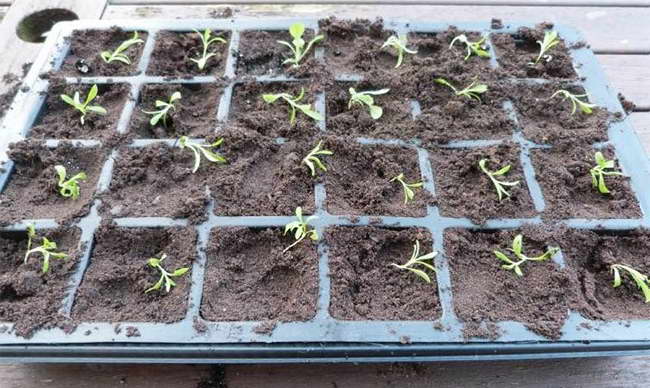

Dive carnation Shabo photo
Sowing seeds early requires a two-stage plant transplant. When 2-4 true leaves appear on the sprouts, it means that the time has come for picking. They make a dive very carefully: they pry the plants with a lump of earth with a small spoon, fork or even a toothpick, move them into new cups and plant them in prepared holes.
First transplant: in time about a month after the first shoots, when the first true leaves were formed. Choose shallow pots with a diameter of up to 8 cm, the soil is the same as in the first planting. Watering as needed is better root from a spray bottle.
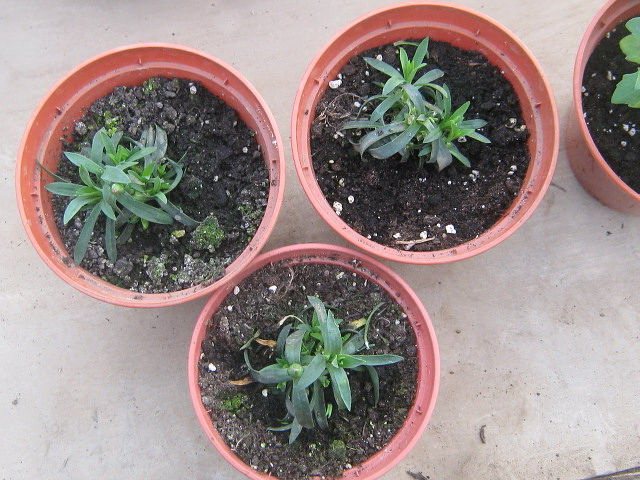

Carnation garden shabo growing from seeds at home Second transplant photo
Second transfer: when the bushes reach 10-15 cm, such seedlings have little soil in the pot, and they cannot be planted in a permanent place for up to 3 months. Containers with a similar substrate with a diameter of 15-20 cm are selected. Compliance with the temperature regime and the appropriate size of the pot allows you to form a branched lush bush.
For the active development of green mass, nitrogen fertilizer is needed; you can simply double the humus content in the soil.To do this, use ready-made organic fertilizers in solid or liquid form. Systematic feeding will allow you to grow strong, branched bushes, and the buds will be large and bright.
How to grow a Shabo carnation from seeds from sowing to diving and pinching, the video will tell:
Recommendations for growing seedlings of Shabo carnations:
- the height of the first pot should not exceed 6 cm;
- during the second transplant, the seedlings are transferred to a new place along with a lump of earth from the previous pot;
- elongated stems can be deepened into the ground, but no more than 2 cm, up to the first pair of leaves;
- it is important to observe the temperature regime up to 15 Сº so that the seedlings do not stretch out;
- in sunny weather, you need to ventilate the room, giving the plant more oxygen;
- you can regularly pinch a bush with 5 pairs of leaves every 2-3 pairs, this will form a spherical shape with abundant green mass;
- when the color of the stem and leaves changes to a lighter shade, it is necessary to apply nitrogen fertilizer, preferably with a solution for root watering;
- the bushes affected by the black leg are promptly removed, and the vacant space is sprinkled with a mixture of wood ash, crushed coal and sand;
- after the second pick, the seedlings begin to harden, they are taken out to the balcony, terrace, greenhouse, greenhouse in order to adapt the plant to low temperatures, gradually decreasing to 5 Сº.
Compliance with the light and thermal regime, regular airing and pinching the bush will definitely give a positive result. By the time it is planted in its permanent location, the plant will be ready to bloom.
Seedling hardening
Gradual acclimatization of the plant will avoid stress when the bush takes a long time to take root, and the beginning of flowering is delayed. It is important to provide the seedlings with comfortable conditions; getting used to night temperatures should be gradual. To do this, take out the containers with seedlings to the balcony every day, first for a short time, and later for the whole day.
Growing carnations in pots to decorate a balcony, veranda, gazebo does not require transplanting from a second pot. The plants are first taken indoors at night until the air temperature drops below 10 ° C, and then they are hung along the edge of the balcony for the whole summer.
When to cut flowers?
The best time for this is early morning. Fresh flowers cut at this time still retain dew drops on leaves, petals, and stems. Plants will not undergo the cutting process as painfully as they are saturated with moisture. They can be cut in the evening when dew falls. In hot weather, flowers evaporate water in large quantities. Such plants will begin to dehydrate earlier, and they will not stand in a vase for a long time. This time of day is not suitable for making a bouquet.
There are many flowers, they have different cutting times. Irises, peonies, tulips, gladioli, lilies, roses are cut during the budding period. But marigolds, dahlias, phloxes, asters - when the flowers bloom.
You always want to collect a bouquet of different flowers, but you should know that not all of them get along with each other. Neighboring in a bouquet - yes, but not everyone agrees to live together. Cloves, lilies of the valley, primrose should not be placed next to other flowers, much less placed in the same vase. They are poisonous and negatively affect their neighbors. There is no need to make a bouquet if tulips, daffodils, lilies, roses are gathered together in it. Tulips will wither. But if you put them in the same vase with a cypress, they will last longer.
Cornflowers, poppies, daisies will quickly fade if lilies are placed in the same vase with them. But there are flowers that must always be placed separately, otherwise they will destroy all the plants in the vase. These include roses, lilies of the valley, carnations, bird cherry.
When to plant seedlings of Shabo carnations in the ground
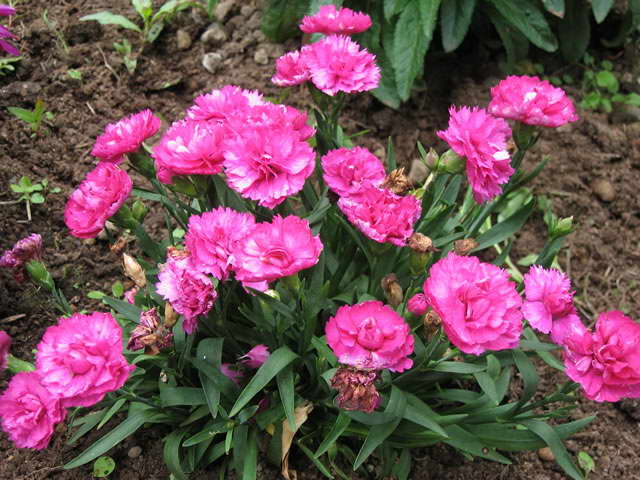

Growing Shabo carnations in the open field When to plant seedlings
Well acclimatized to low temperatures, the Shabo carnation is not afraid of short-term spring frosts, when the thermometer drops to 0 C, a frequent occurrence in central Russia and the northern regions. In open ground, seedlings can be transferred to a permanent place in early May. In the south of the country, where spring comes earlier, the dates are shifted back by 3-4 weeks, to the beginning of April.
Soil requirements
Clove responds well to organic fertilizers, but does not tolerate fresh manure. To ensure the fertility of the soil, rotted compost, river sand for air exchange and good permeability are introduced. Peat will provide protection against stagnant water, make the soil light. A neutral or slightly alkaline earth is best.
For active growth, you need a lot of nutrients, which are not in sand and clay, so this soil is not suitable for cloves. The flowerbed must be prepared in advance, it is better to start in the fall, so as not to delay the growing season. In autumn, phosphate fertilizers and humus are applied, in the spring a mineral complex.
How to make flowers last longer
In order for cut flowers in a vase to last longer, some rules must be followed. Separate rules exist for each type of flower. But there are general recommendations as well. I'll start with them.
How often we are presented with beautiful bouquets of different flowers. They look very impressive! But, unfortunately, as a rule, they do not stand for a long time. Flowers in such prefabricated bouquets begin to wither rather quickly. Why is this happening? It turns out that not all flowers are compatible with each other. Therefore, if you want your flowers to last as long as possible, it is advisable not to keep different types of flowers in the same vase.
How different flowers affect each other
- Roses
, just like
carnation
will fade much faster if you put them with any other flowers. That is, in one vase there can be only one roses, or only one carnation! - Many people like to make bouquets from daffodils
from
tulips
, but if you do this, the tulips will wither very quickly. Daffodils are incompatible with tulips! - Colors that speed up the wilting of other colors include: lilies of the valley, daffodils, mignonette, pipe lilies and sweet peas.
- Many flowers can extend the life of: sprig of thuja, cypress
or
geraniums
.
Choosing a flower vase
When choosing which vase to put cut flowers in, keep in mind that the flowers should not be cramped in it, but not too loose, so that the stems do not fall.
Vase height
should be about the middle of the flower stem.
Water level
in a vase usually does not greatly affect the preservation of flowers. But if there is fluff on the stems of flowers, then the water should be no more than a third of the stem.
If you were presented with a bouquet, then after bringing it home you need to cut off the ends of the stems by 1-2 cm and it is advisable to immerse the flowers in water for 1-2 hours until the flower itself. And only then put it in a vase.
To make the flowers last longer, you need to remove the leaves from the part of the flower stem that is in the water.
If a the stems of the flowers are solid
(like chrysanthemums and peonies), then their ends need to be split by 3-4 cm.
Hard ends of shrubs
(for example, lilac, jasmine) must be crushed to a height of 5-10 cm.
If a flower stems are soft
then just make even cuts.
Require special care dahlias, poppy, mignonette, daisies
... The ends of the stems of these flowers must first be quickly burned over a fire, and then placed in cold water.
Flowers need to be changed every day, the stems should be washed with water and cut by 1 cm.
What can be added to the water to make flowers last longer?
Some substances dissolved in water can increase the lifespan of cut flowers. To keep the flowers in water for a long time, you can dissolve:
- aspirin
(1 tablet per 1 l) - table salt
(0.2 g per 1 l) - sugar
(half a teaspoon per 1 liter), but sugar is not good for all flowers - glucose
(make 1 -% - th solution) - glycerol
(1-2%) - alcohol
(10%)
To make roses last longer
In order for roses to last longer, they must be cut under water, leaves and thorns removed from below. The water in which it is planned to put the roses must be well settled. An aspirin tablet should be added to this water.
To make carnations last longer
In order for the carnations to last longer, you need to add boric acid to the water at the rate of 0.1 g per liter of water. Cloves are best served with water at room temperature. Note that these colors do not need to change the water too often.
For lilies to stand for a long time
In order for the lilies to stand longer, the ends of their stems must be dipped into water heated to 60 degrees, and held there for two minutes. In addition, lilies will last longer if their stamens are removed. This can be done conveniently with tweezers.
For gerberas to stand for a long time
Gerberas have a hairy stem that should not be immersed deep in water. Pour enough liquid into the vase so that no more than one third of the stem is in the water. It is recommended to immerse them in water no more than 5 cm. Add salt to the water at the rate of one teaspoon per liter of water. Please note that these flowers do not like drafts very much.
To make dahlias last longer
Cut dahlias will last longer if the water is slightly acidified with vinegar. To do this, add 1 tablespoon of 9% vinegar to the vase. One aspirin tablet can be used instead of vinegar.
Take note of these easy ways to preserve cut flowers and make them happy for longer.
Now, I’ll give you some helpful tips to help you when shopping for cut flowers.
- At the time of buying roses
pay special attention to the bud - it should be dense and elastic. - Lilies
it is advisable to buy with stamens removed. Not only does yellow pollen get very dirty. If this pollen gets on the pistil, then the flower will begin to die. - Buying chrysanthemums
, pay attention to the stem of the flower. The leaves should be juicy, not lethargic or dry, and the cut should be light. Look at the core of the flower. It is good if it is still devoid of color, that is, greenish or white. - By choosing tulips
, be wary of flowers whose heads are compressed with rubber bands. Most likely, they have been cut for a long time, and will not stand for long. - Do not buy pre-assembled bouquet
... Most likely, it will not last long. It is better to ask the seller to make a bouquet right in front of you.
Well, now you are fully armed, and you can take at least some measures so that the flowers designed to delight you with their beauty can fulfill their task as long as possible.
And further. When you buy flowers for someone as a gift, do you know that each flower color means something
, and a person who knows about the symbolism of flowers can interpret your gift in a completely different sense, not the one that you put into it. In order not to be mistaken, I advise you to read.
Since today I have a theme about flowers, I decided to please you with beauty. I made a beautiful slideshow "Flowers in a Vase" with very gentle music by Michel Pepe. I myself have received great pleasure working on this gift for you.
Get your portion of positive and you!
Chinese carnation, just the charm of my garden, I really love it for its long bloom, which you can't take your eyes off. However, winter frosts are not always favorable to carnations, and I am very afraid of losing this variety. So we have to do the wintering in several ways, with the expectation that at least something will survive. When autumn has already fully come into its own, but there is still no persistent frost, I dig out a couple of carnation bushes and transplant them into flower pots.
Often there are still buds on the cuttings, but you don't need to hope for their flowering in the house, the buds will still wither.
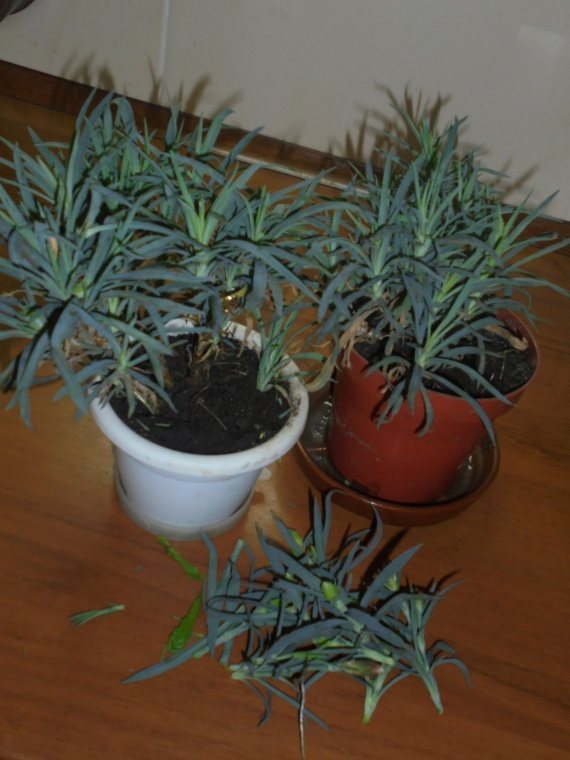

So I cut them off. And I put the pots on the coldest windowsill.In this state, the carnation is waiting for spring. I water it extremely rarely, I let the earthen coma dry out slightly. With the arrival of spring, I dig a bush and cut it into fresh ground. Since I carry out cuttings in room conditions, I do it at the end of February, beginning of March. These bushes bloom much earlier.
I'm digging up a few bushes.
Together with an earthen lump, I put all the bushes into a paper bag from under the cement. Then I wrap everything in foil.
I put this whole package to winter in a garden mini greenhouse, where cuttings of roses and boxwood are already wintering. The neighborhood does not affect wintering in any way. Before the very frosts, I shovel leaves there, and before the frost intensifies, I also throw felt there. In this state, I save the cuttings until spring. The most amazing thing is that when I open this package, it seems that they were wrapped not in the fall, but just recently. Overwintering is tolerated just fine. When the temperature in the greenhouse is already above zero, day and night, I cut it into the same greenhouse. There are quite a lot of cuttings, because before wintering I do not cut them at all. When the bushes grow up and get stronger, I plant them in open ground.
Another wintering method, which I also use for reliability, is a simple covering of bushes with cans or plastic bottles. I don't really like this method, because such shelters do not look aesthetically pleasing in the garden. Especially if the landings are in prominent, walkable places. But, if the bushes are small and covered with small jars, then you can cover them with leaves. However, the wind scatters the leaves and exposes little attractive bottles.
My experience has been tested over the years, since before I could not protect carnations from freezing in any way, and with the help of such methods, everything hibernates wonderfully.
Prolonging the life of cut flowers is not so difficult - just follow some simple tips.
123RF / zamuruev
How to plant Shabo carnation seedlings in open ground
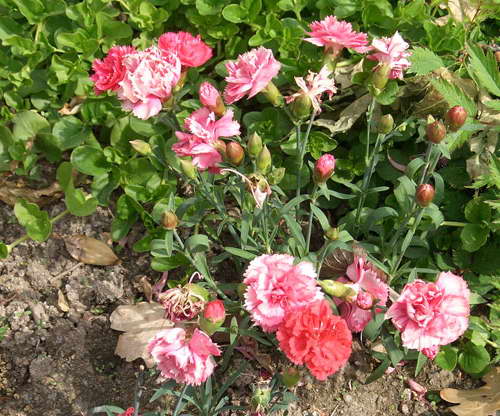

How to plant a Shabo carnation Shabo carnation on a flower bed photo
- The plant, together with a lump of earth, is placed in a hole previously shed with warm water, ensuring the same level of deepening.
- The lower leaves should not be in close contact with the ground, this will prevent the development of putrefactive diseases.
- The distance between the bushes is about 20-25 cm if we want to create a dense carpet. Sparse plantings are made at a distance of 40-50 cm.
- After planting, they water it well, mulch the ground with a layer of humus of 2-3 cm. This will retain moisture and will become an excellent nutrition for developing plants during subsequent watering.
Bouquet preparation
Choose a vase according to the size of the bouquet so that the stems of the flowers are not pressed against each other. It is better not to fill the vase from the tap, but to use settled or filtered warm water.
For all colors, follow the main rule:
before placing the bouquet in the vase, remove the lower leaves from the stem, and the roses also have thorns to avoid rotting in the water.
For flowers with a hard stem (roses, chrysanthemums), make an oblique cut with a sharp knife to increase the area of moisture absorption. This procedure must be done under water so that air bubbles do not clog the vessels of plant tissue. Do not use scissors for this so as not to flatten the capillaries. Split the stem into three to four centimeters and put a piece of a match in the split - this will increase the absorption of moisture even more.
For flowers with a hollow stem (dahlias, lupines), pour water inside the stem, and plug the hole with cotton wool or a piece of gauze. Remove all leaves from the branches of shrubs (lilac, jasmine) and split the tip of the trunk.
A flower that secretes milky juice must be cut under water, since in the air it immediately hardens, clogging up the vessels. To stop the release of juice, the end of the stem must be dipped in boiling water for a couple of seconds or burned over a fire.
For soft-stemmed plants (tulips, daffodils, calla lilies, gladioli), cut the bottom of the stem or make several vertical scratches on it with a needle. Treat the cuts of calla lilies and gerberas with salt, and dip the stems of carnations in alcohol for a few seconds.
123RF / Nelli Syrotynska
Secrets of growing Shabo carnations in the garden
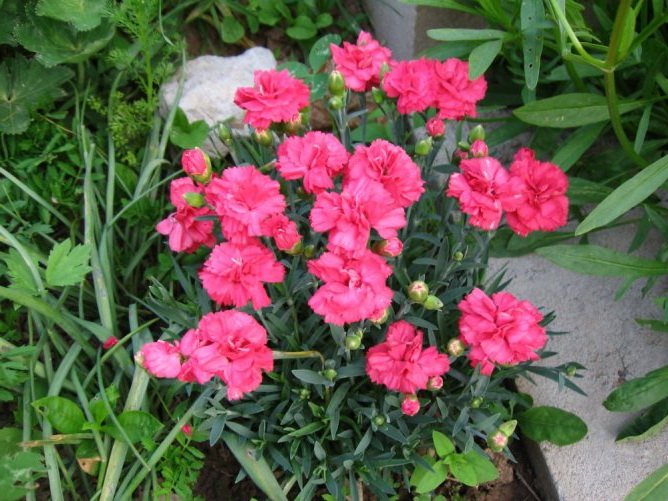

Carnation garden Shabo planting and care
To grow large inflorescences on long stems, which are needed for bouquet cutting, you need to follow simple rules, do not forget about the finickyness of the plant:
- Systematic abundant watering will avoid the weak development of the bushes, and the mulch applied in time will protect against drying out of the soil and oxygen starvation of the roots (the air permeability of the soil will significantly improve).
- Loosening the soil provides additional aeration, the roots receive a sufficient amount of oxygen. It is important to carry out the procedure after heavy watering or rainfall.
- A week after planting in the ground, the plant is fed with nitrogen solutions, the second time the procedure is repeated during the period of active budding with complex mineral fertilizers.
- Tall species need artificial support.
- If large buds are needed, then the side shoots are cut off so that all the energy and nutrients go to the central shoot.
- An unheated greenhouse will not help ensure early sowing, but it will work great for hardening.
In autumn, you can move the pots with the plant indoors, but it is better to lower the temperature to 15-20 Сº. If the seed method was unsuccessful, do not despair, you can prepare cuttings. To do this, in the spring, shoots are cut from the mother bush, they are placed in wet sand so that they have time to give roots. This method speeds up the growing season, but the buds will be smaller.
Carnation Shabo will fill a garden or city flower bed with a charming aroma, will delight with its magnificent flowering throughout the warm season.
Disinfection and feeding
Flowers in a vase are most affected by the rapid development of bacteria in the water. Various disinfection methods slow down this process. Put pieces of charcoal in the water, a silver coin, as was done in the old days, or add washing powder at the tip of a knife. For the same purpose, you can slightly salt water in a vase of flowers (one teaspoon of table salt per liter of water).
To kill microorganisms, add aspirin or streptocide (one tablet to six liters of water), sugar and vinegar (one tablespoon per liter of water), boric acid (0.1 grams per liter of water), lemon juice quenched (not more than one tablespoon per liter of water), potassium permanganate (on the tip of a knife). All these products contribute to the destruction of microorganisms in the water, prevent the decay process and allow the living flowers to not fade for a long time.
Sugar is commonly used to feed the flowers in the vase. This is especially helpful for tulips, carnations, daffodils. Roses and chrysanthemums respond positively to aspirin, while dahlias are good at adding a little vinegar to the water. But aster feels much better in a weak alcohol solution (one teaspoon of alcohol per liter of water).
In addition, flower shops sell special additives to prolong the life of flowers. They already contain all the necessary disinfectants and nutrients.
123RF / Konstantin Malkov
Carnation perennial Shabo wintering in the garden Shelter for the winter
The Shabo carnation may well overwinter in the garden, if the gardener is not too lazy to perform a number of operations.
- In the fall, carnation bushes are cut by a third, along with faded buds. Pruned shoots can be buried in the garden for the winter and used for cuttings in the spring.
- The shoots are gently tilted (you can first make an earthen roller so as not to break the shoots), sprinkle with a layer of soil of at least 20 cm.
- Cover the top with a thick layer of straw or hay (about 50 cm). Such a shelter will reliably save the Shabo carnation from frost.
In the spring, after the snow melts, the straw is first removed, and when the ground thaws, the shoots themselves are released (it is important that the frost has already passed). Carefully examine the bush, cut out all damaged or under-grown sprouts.
Preparing flowers for life in a vase
To prevent air from entering the stem and clogging the pores through which nutrients enter, the stem must be cut without removing it from the water, at an oblique angle and with a sharp knife. After that, the plant should always remain in the liquid.
Many flowers are distinguished by the presence of thick and hard stems. In this case, their tips need to be split about five centimeters up the length of the trunk. It is recommended to insert a match into the middle, so moisture will be absorbed more actively. If the stems of the flowers are soft, they need to be scratched or cut at the bottom to increase the area through which moisture will flow to the plant.
Hollow stems for a long time? They should be properly prepared. To do this, pour water into each stem, and plug the hole with cotton wool. It happens that a lot of milky juice flows out of the plant. In this case, you need to dip the stems in boiling water or burn their tips with fire.
Many flowers have long stamens. If their anthers are carefully removed, the flowers will last longer.
Can Shabo cloves be kept at home in winter?
Especially valuable varieties of Shabo carnations can be dug up in the fall and transplanted into pots in order to keep them at home in winter. To do this, the bushes with a clod of earth are dug up, carefully moved into a pot, trying not to violate the integrity of the earth clod.
The planted Shabo carnation is cut to a third of the height and watered with a little water. Gradually, the bushes are watered less and less, and the temperature of the content is reduced (by putting it, for example, on a loggia, and when it is completely cold, the pot is moved to the northern windowsill).
Around mid-February, flowers are placed in a warm, well-lit place and watered abundantly. It is also important to feed the flowering fertilizer to stimulate the growth of shoots and the establishment of flower buds. The regrown axillary shoots are used for cutting Shabo carnations.
The mother plant is freed from dried old shoots (they must be carefully cut off) and planted back in the garden in the spring.
How to place the bouquet?
Flowers should be kept in a bright room, avoiding direct sunlight. It is also undesirable for drafts in the room. Indoor temperature also plays an important role: in cooler climates, flowers last better.
Roses, carnations, orchids, lilies, daffodils, poppies, lilies of the valley should be placed in vases separately from other flowers, then they will last longer. Twigs of geranium, thuja, woodruff, on the contrary, help keep flowers fresh.
Do not place the vase near where the fruit is stored: the fruit emits ethylene gas, which accelerates the decay process.
How to propagate a Shabo carnation by cuttings
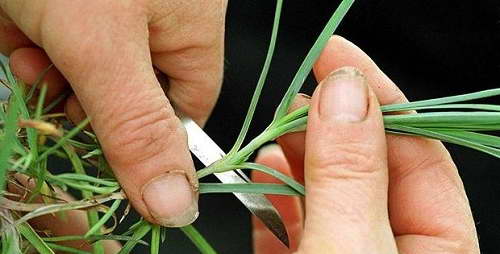

How to cut a carnation Shabo photo
Cutting Shabo carnations is a common breeding method. For this:
- Cut the cuttings 5 cm long or more.
- Remove the lower leaves.
- They are kept in a solution of heteroauxin or root according to the instructions.
- They are planted in prepared containers with soil for flowering plants.
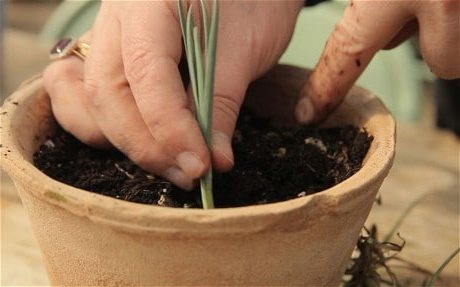

Reproduction of Shabo carnations by cuttings
- Moisten the substrate and cover the containers with cling film, plastic container or glass to create greenhouse conditions.
- Airing is carried out daily.
- When the first shoots appear, they begin to harden the seedlings, arranging air baths without shelter, gradually increasing the time.
- When the plants get used to it, the film or glass can be removed.
Ready-made seedlings can be planted in the garden in warm, frost-free weather. Such plants will bloom much earlier than those grown from seeds.
Video about grafting Shabo carnations:
Diseases and pests - how to treat
Cloves rarely get sick with proper care.Due to the high humidity during rains, fungal infections overwhelm her. Diseased plants are removed from the site and burned, the rest are treated with copper-containing fungicides.
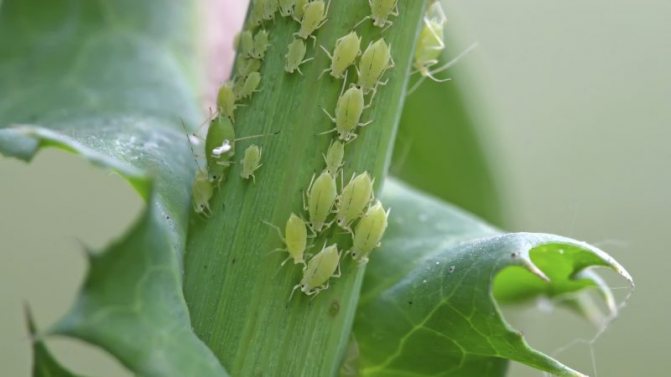

Insect pests - mites, aphids and thrips - cause significant harm to the flower garden with carnations. They suck out the plant sap, which is why the plants are deformed and stunted. If there are few insects, folk methods will help - treatment with tar soap, infusion of onion husks or tobacco. In case of severe damage, systemic insecticides are used, watering the plants at the root.
Carnation Shabo at home
Many enthusiastic growers are happy to grow Shabo carnations at home. Since the hybrid is a perennial, the plant feels great in an apartment and blooms profusely. The main condition is to water on time, feed often (you can every two weeks) and provide good ventilation.
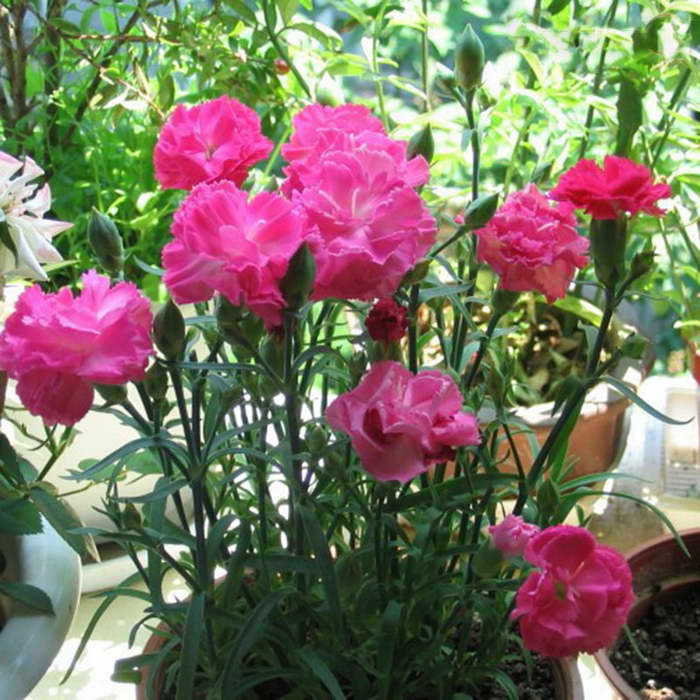

Carnation Shabo at home how to care
Carnation Shabo prefers low temperatures up to 24 ° C and long daylight hours. In winter, the plant can be provided with a dormant period, starting in September. To do this, reduce watering and move the beauty to a cold place with a temperature of 12-14 ° C. In February, they return to the light warm windowsill and begin to water and feed abundantly. The beauty immediately sprouts new shoots and flower buds.
After 4-5 years, the bush will begin to age, but it does not matter: you can use its shoots for cuttings or re-sow seeds for seedlings.
Why do cut flowers fade?
It is believed that plants are less sensitive than humans. This is not entirely true. Plants, like all living organisms, are subject to stress. But they don't have the ability to say so. When flowers are cut, they are deprived of nutrients and water. This is stressful for them.
Flowers begin to wilt, as the amount of sugars and moisture in their tissues decreases, which leads to dehydration. This happens because the vessels of the plant are clogged with air bubbles.
How to extend the life of cut flowers? To do this, you need to put them in water, having previously prepared the container, liquid and plants. Then provide proper care.
Use in landscape design
Handsome Shabo is an especially favorite type of carnation for creative designers. Bright and graceful, at the same time very delicate, but unpretentious flower. In addition, Shabo is so different, it will perfectly fit into any floristic picture (Figure 6).


Figure 6. Flower culture is actively used in landscape design
Low varieties can beautifully frame an island flower bed, or become part of mixborders, they are also widely used in hanging and floor pots, which are located on terraces and balconies. Alpine slides and rockeries will also gladly accept such guests. High varieties can become worthy accents in the color composition of the landscape. From the neighbors, you can advise dark green conifers. Against their background, our Shabo looks very advantageous.
Yes, this type of carnation will take you a lot of time and effort, but it will more than pay off with its long and fragrant flowering.
Detailed instructions for planting a flower are given in the video.
Preparing the soil for planting
Turkish carnation loves sunny or slightly shaded places, in quiet corners of the garden they feel most comfortable. Planting flowers is made from seeds, you can start it in June. It is advisable to prepare the soil for sowing in advance by mixing peat, sand and humus in equal proportions. Carnations are sown in even rows, leaving an equal distance of about 15 cm between them. Before sowing, it is advisable to water the grooves in order to moisten the soil well. A grown carnation can start to come out of the ground quite often, in which case it should be thinned out. Mature plants lend themselves well to transplanting.
Care features
Growing a Shabo carnation from seeds is not an easy task - planting and subsequent care for it is quite difficult for a novice gardener.
To maintain the health of the plant, its abundant flowering and beautiful appearance, you must adhere to the following rules:
- Top dressing... Nitrogen fertilizers are applied 10 days after transplanting. During budding - potash / nitrogen-potash. To ensure long-term and abundant flowering, the flower is fed often and in small portions - once every 14 days. If the leaves at the base have become lighter than the middle, then additional nitrogen fertilization is required.
- Garter... So that the stems of tall varieties are even and not bend, they are tied to a support.
- Watering... Watering is provided regularly. The soil should be slightly moist.
- Cut... To make the flowers larger, the side buds are cut off. Stepchildren up to 6 knots are removed, cutting is carried out in the phase of a half-opened bud.
In addition, good drainage of the soil is ensured - after precipitation and irrigation, it is carefully loosened. A preventive examination is carried out - dry and damaged leaves, faded buds are removed, weeds are removed. Inspect for diseases and pests.
Basically, the Shabo group is grown in garden conditions. But after the onset of cold weather, it can be transplanted into a pot and transferred to the house. In such conditions, it can bloom until the beginning of winter. The content of the plant is the same as when growing seedlings - low temperature and bright lighting. After wintering, the culture in the spring can be used for cuttings.
Planting and flowering, video:
Growing plants
As soon as shoots appear, the film must be removed immediately, and the plants must be placed in slightly different conditions:
- Provide the brightest possible lighting by placing on a south window or backlit;
- lower the temperature even more, to indicators of 12-13 degrees (without lowering the temperature, the seedlings will stretch out and it will not be easy to achieve thickening and abundant flowering from them).
At the stage of seedling growing, the greatest danger to the Shabo carnation is the black stem. It is necessary to moisten the soil very carefully, controlling the rate of drying out of the substrate and maintaining only light moisture. Too elongated, thin and fragile stems, you can gently add soil as they grow.
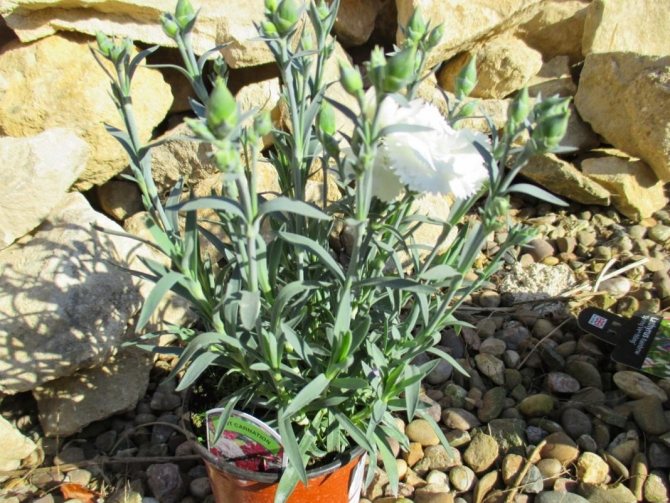

Seedling of garden carnation.
Watering
Particular attention is paid to watering. The soil under the seedlings should not be dry, so you need to monitor its moisture. But it is not worth pouring either - cloves do not like stagnant water. Young sprouts are regularly sprayed with warm water from a spray bottle. The dived seedlings are already watered from a watering can using water at room temperature. It is better to water "adult" seedlings through a pallet - this way the root system will develop more actively. The basic principle of watering carnation seedlings is often, but little by little.
Outcomes
All that is needed to grow a carnation at home is to care for it, providing the right conditions.
Its cultivation is unthinkable without bright sunlight. And in order for the plant to bloom longer, there are special fertilizers.
The plant is also very vulnerable to pests. They are required to carry out preventive treatment.
We hope that our article helped you decide on the most suitable carnation variety for you and with the cultivation of the chosen flower at home.
Sowing seeds in greenhouses
You can grow cloves not by sowing seedlings in containers, but in the soil of the greenhouse, if the temperature in it reaches at least 12 degrees Celsius. Sowing is also carried out in January or, as a last resort, in February, and then a pick is carried out into the seed boxes at the first stage and into individual pots or greenhouses at the second. With this sowing, seedlings appear twice as long, up to 10 days for the first shoots.
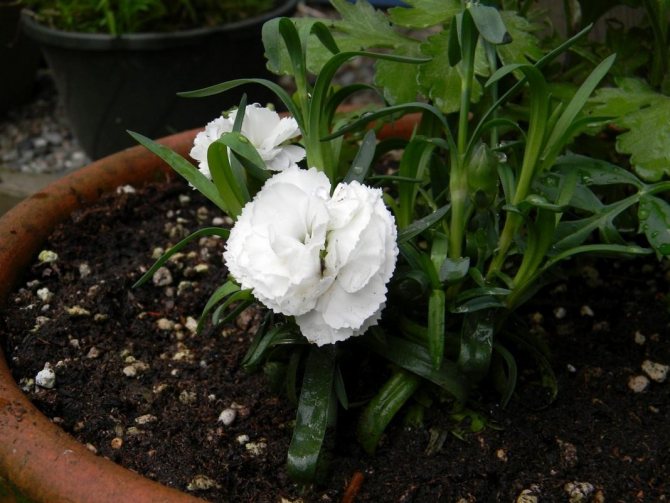

Garden carnation. <>
Turkish carnation care rules
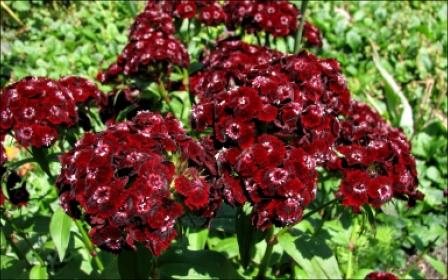

- in the fall, when the carnation has faded, the heads are cut off, the stems are shortened - weeding - loosening the soil - watering - top dressing
If you properly care for a Turkish garden perennial carnation, it will grow for more than 6 years and delight you with its flowering. Due to its unpretentiousness, it can be planted in any corner of the garden, you can grow dwarf carnations in pots in an apartment, which will create coziness and decorate your house with bright colors of small inflorescences.
Share information with your friends on social networks
Perennial garden carnation is the ancestor of the cultivated Carnation. This flower is mentioned in ancient Roman literature, where it is called "divine". Indeed, despite its modest beauty, the perennial garden carnation has many names. It is called "Field Tears", "Maiden Grass", "Flower of Zeus" and these are not all names.
Soil and containers for sowing
For sowing Shabo carnations, use a universal lightweight seedling substrate with a neutral reaction. If you are preparing the soil yourself, then for this clove, choose a mixture of equal parts of turf or garden soil, humus and peat, to which add half the amount of sand.
For Shabo carnations, use special containers for seedlings, boxes, photo cuvettes or flat bowls, low large containers with drainage holes. It is better if the height of the containers does not exceed 5-6 cm. Deep containers increase the risk of excess moisture and seedling loss. All containers (if materials permit) must be disinfected with a solution of potassium permanganate or boiling water.
Dive seedlings
This carnation will need not one, but two picks. The reason for this feature is very simple: too early sowing imposes its own specific requirements for growing plants. Shabo shoots, after being transferred to individual containers, are actively developing and by the time the cups become small for them, there is still a lot of time left for transfer to a permanent place. Therefore, they need to be dived into large pots for the further development of plants.
Diving is carried out in the same soil mixture as for sowing; if possible, use a substrate with a doubled amount of humus (or add a handful of organic fertilizers to the finished soil).
The first picking of Shabo carnations is carried out in a phase that is standard for almost any seedling - the appearance of the first pair of true leaves. Seedlings must be planted in small individual containers, seedling cassettes with a cell diameter of about 3 -4 cm. Plants can also be planted in a common large container, but its height should not exceed 6 cm.
The second pick is carried out at the stage of full development of the fourth pair of true leaves (approximately at the end of March). Plants are transferred, completely preserving the earthen lump. The containers are more than doubled to a diameter of 10 cm.
At each dive, the plants must be handled carefully, keeping the same level of deepening (if the plants are stretched, then they can be deepened no more than 2 cm), trying not to expose the roots too much and keep as much old soil around the roots as possible.
Water preparation
Based on experience, it has been noted that soft water prolongs the life of cut flowers. It is better to take it from a spring or accumulate rainwater. If there is none, melt or tap water is used, but not immediately from the tap. It must be poured and left for a day to weather the chlorine.
Bacteria are more dangerous for flowers. Their reproduction occurs very quickly, which significantly shortens the life of the flowers in the vase. To preserve them for a longer time, you need to add substances endowed with disinfecting properties to the water:
- Silver coin.
- Small amount of washing powder.
- Charcoal.
- A tablet of streptocide or aspirin in six liters of water.
Per liter of water:
- Table salt - a teaspoon.
- Boric acid - one hundred milligrams.
- Soda with lemon juice - a tablespoon.
- Sugar with vinegar - the same amount.
What you need to know when propagating indoor carnations
At home, it is better to propagate cloves by seeds - because it is simple, and this genus has good seed germination. In addition, experiments with crossing different varieties provide original results. Seeds should be sown in the first half of spring. Moreover, the seeds should not be stored for a long time: the best germination is from the specimens of the last year.
For the first time, a carnation blooms after three or four months from the moment of planting. And the bushes, planted in early spring, bloom until the frost.
Important! In principle, planting can be done even in the fall, but then you can not wait for flowering until late spring.
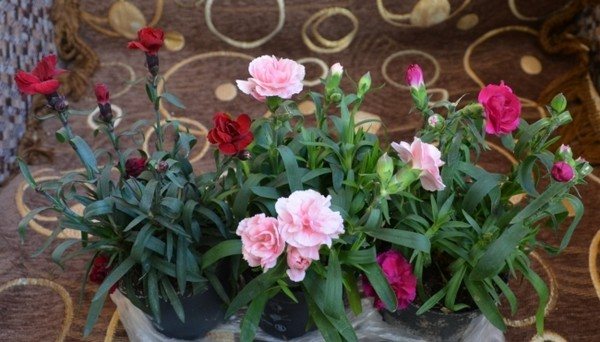

As a rule, carnations bloom 3-4 months after planting.
Biennial and perennial species can reproduce by dividing the bush and grafting.
Be that as it may, too young a carnation is contraindicated to be in the soil at great depths. Even the plant, even the youngest, needs watering. In order to avoid stagnation of moisture and subsequent rotting of the roots, sand can be mixed into the soil.
So, how to properly propagate indoor carnations.
| rules | Description |
| Rule # 1 | The seeds do not need to be soaked before planting. It is enough to place them in a small pot of earth and pour generously with warm water. |
| Rule # 2 | The pot should be placed in a warm and well-lit place, and then shoots can be observed literally in a week. |
| Rule # 3 | As soon as young bushes grow from the seedlings, and they will have at least five real leaves, the formation of the plant should be done, that is, pinch the top and side shoots. |
| Rule # 4 | The carnation blooms luxuriantly three or four months after being planted in a pot. Planted in the first half of spring, it then decorates the room until the very autumn cold. In principle, you can plant a carnation even in the fall, but the first flowering will take place only after six months. |


There are certain rules for growing indoor carnations.
Feeding cut flowers
The most commonly used sugar, which responds well to many flowers, including carnations, tulips, daffodils. You can make your own nutrient solutions using a variety of ingredients.
For chrysanthemums, cyclamens and gerberas, a mixture is suitable, in percentage, of alum, sodium and potassium chloride, sugar, respectively: 0.08; 0.02; 0.03; 1.5.
Roses and carnations respond well to the composition, in milligrams, of aluminum sulfate, citric acid, silver nitrate, sucrose, respectively: 500; 150; fifty; thirty.
Today there are many drugs on sale that can prolong the life of cut flowers, one of them is "Bud". The substances included in it simultaneously disinfect and nourish plants. Flowers last twenty-five days longer.
Folk remedies for preserving flowers in a vase
Cut flowers always help to create coziness in the house. In order for their life to be relatively long, you need to take care of this. For a long time, rot-preventing substances and nutritional supplements have been added to the water where the flowers stood. Here is some of them:
- Changing the water daily, add vodka and sugar to it, a teaspoon and a piece, respectively.
- You need to immerse the stems in water at least ten centimeters. Change the water every three days, adding sugar and vinegar in a teaspoon.
- When changing water after two days, mix three drops per liter of bleach and water each time.
- A sweet soda cut flower dressing is used with daily water changes. Fifty grams of cola is added to it in a dark vase, and the same amount of sprite in a light one.
Varietal varieties
The varieties of this species are very diverse, and every year more and more new ones are bred.There are classic "old" varieties that are easier to care for and are good for beginners, but there is also a lot of interesting material for experienced gardeners. Below are several proven varieties of handsome Shabo (Figure 2).
Let's try to divide them by shades:
- White carnation: fragrant Mont Blanc and with huge buds Jeanne Dionysus.
- Yellow carnation: delicate golden Champagne, bright yellow Marie Chabot and orange Fire King (the name speaks for itself).
- Red clove: La France with pale pink flowers, ruby red, maroon Lejeune D'Oner and red and black velvet Nero.
- Lilac Carnation: rich purple Mikado, purple Girofle.


Figure 2. The best varieties of culture: 1 - Mont Blanc, 2 - Champagne, 3 - La France, 4 - Mikado
All these species can be planted either separately or make interesting flower arrangements in flower beds from them, since caring for crops of different shades is no different.
Place for a bouquet
Cut flowers, photos of which are presented for viewing, will stand much longer if you take care of them correctly. In many ways, their freshness is influenced by the place they were given in the house. To keep flowers longer, you should adhere to the following recommendations:
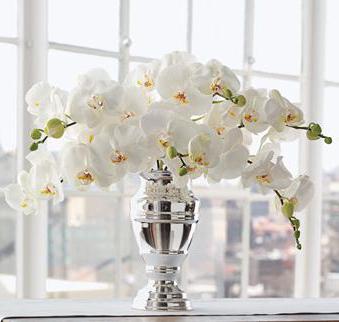

- Choose a place for flowers with natural light, but so that they do not fall on the direct rays of the sun.
- The room should be cool and no drafts.
- Bouquets and fruits should not be placed next to them, as the fruits emit ethylene, which accelerates decay.
- It is necessary to take into account the compatibility of the plants in the bouquet. So, lilies, roses, lilies of the valley, daffodils, orchids are better off living in a vase apart. Conversely, thuja and geranium are always welcome guests for any flowers, they keep their freshness.
Stalk processing
To prolong the life of cut flowers, the following recommendations should be observed:
- On the part of the stem that is in the water, you need to remove the leaves, otherwise they will begin to rot. Such an environment is favorable for the growth of bacteria that will damage the entire plant.
- The tip of each stem should be cut at an angle. This increases the absorption area for moisture. The cut is made with a sharp, disinfected knife, after which the stem must be immediately immersed in water. The stems of flowers such as roses are best trimmed immediately under water to prevent clogging of blood vessels by air.
- To preserve flowers for a long time, you need to subject them to a hardening procedure. For this, the plants are placed in hot water, the temperature of which reaches forty-four degrees. In this case, a vase of flowers should be placed in a cooler place for two hours. Water molecules of this temperature move faster along the stem, and due to the cool air of the environment, the flowers will lose moisture in smaller quantities. This increases the life of the flowers in the vase.
- If cut flowers are not hardened, they should be placed in warm water, which they absorb better. But for bulbous plants it is better to use cold water.
- The stem needs to be processed throughout the life of cut flowers. As soon as rotten, slippery leaves appear, they need to be torn off, the stem and vase should be washed, the water changed, and only then the flowers should be placed in a container for them. When flowers that emit ethylene wilt, they must be removed immediately, otherwise the rest will be the same.
What are the challenges facing a gardener growing carnations at home?
Alas, when growing carnations, some problems are not excluded, and they must be taken into account even before planting a plant. Of course, it is not difficult to provide the proper conditions, but this flower is vulnerable to pests. For example, to such:
- spider mite - greatly impairs flowering and covers the back of the foliage with a white bloom;
- aphid;
- powdery mildew.


Indoor carnation is very "loved" by aphids, spider mites
Because of this vulnerability of the plant, everyone who grows it should be prepared for the fact that it is not so rare to carry out antiparasitic measures.
Pest threats are very serious. If at least one plant is affected on the windowsill, the carnation must be removed from there immediately. If there are signs of pathology, it is required to wash the foliage with soapy water, carefully protecting the roots from getting soap on them. Once on the roots, the soap will certainly harm the plant. The foam is washed off after a few hours, but it should not be left overnight.
Important! Folk remedies can also help against pests. For example, infusions of yarrow and tansy are a good remedy for spider mites.


You can get rid of pests using folk methods or special preparations.
If all this turns out to be useless, it is recommended to buy special fungicides in the phyto-pharmacy. Here are some examples of drugs that are kind of "heavy weapons" in such cases:
- "Actellik" - perfectly fights most pests, but it is toxic, and it is better to resort to it only when nothing else helps;
- Fitoverm is not so dangerous, but this does not prevent you from carefully following the instructions.
Important! Poor quality soil is also a common cause of clove disease. Even having bought soil in a specialized store, not to mention picking up in the garden, it must be treated from bacteria - spilled with a weak manganese solution.


It is recommended to process the soil before planting cloves there.

